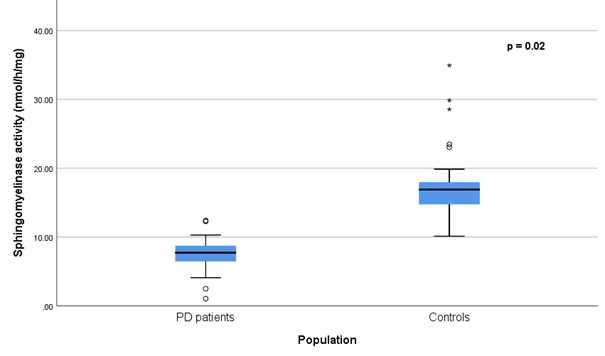Objective: To measure the sphingomyelinase (ASMase) activity in sporadic PD patients and matched healthy controls and identify any clinical or biological correlation with disease’s severity.To measure the sphingomyelinase (ASMase) activity in sporadic PD patients and matched healthy controls and identify any clinical or biological correlation with disease’s severity.
Background: The pathogenesis of Parkinson’s disease (PD) is still unknown. It is commonly admitted that it is resulting from a complex interplay between genetic and environmental factors. While most cases are classified as sporadic (90%), over the last decades, various genes were identified that cause PD when mutated. SMPD1 mutation, known to cause Niemann-Pick Disease, was reported as a novel risk factor for PD [1,2]. More recently, lipids have emerged to play a crucial role in the pathogenesis of PD. Remarkably, many studies have found altered levels of ceramide, the basic sphingolipid, in PD patients, suggesting a critical role for this lipid in the pathogenesis of PD [3,4]. Our work focuses on the Sphingomyelinase (ASMase), a lysosomal enzyme coded by the SMPD1 gene and involved in the ceramide metabolism.
Method: Flow cytometry was used to measure lysosomal ASMase activity in lymphocytes from 50 sporadic PD patients and 50 age/gender-matched healthy controls. All participants underwent a neurological examination, including a motor severity assessment by MDS-UPDRS scale and modified Hoehn and Yahr scale (H&Y), along with a measure of blood glucose and lipids.
Results: ASMase activity was significantly reduced in PD group (7.5 nmol/h/mg ± 2.17 vs 17.08 ± 4.6; p= 0.02; OR=3.54) [figure1]. Within PD group, lower ASMase activity was correlated with H&Y ≥ 3 (p= 0.041; OR =0.69). Enzymatic activity was not correlated to the other studied variables: Age, sex, BMI, PD duration, MDS-UPDRS score, glucose and lipids levels (p> 0.05).
Conclusion: Our study revealed a reduced ASMase activity in patients with sporadic PD and a correlation with its severity. We found only one similar study and it did not reveal a difference between patients and controls [5]. Larger sample studies are needed to corroborate these findings. If confirmed, it could be a step towards the first biomarker for PD.
ASMase activity in PD patients and controls
References: [1] Z. Gan-Or, A. Orr-Urtreger, R. N. Alcalay, S. Bressman, N. Giladi, et G. A. Rouleau, « The emerging role of SMPD1 mutations in Parkinson’s disease: Implications for future studies », Parkinsonism Relat. Disord., vol. 21, no 10, p. 1294‑1295, oct. 2015, doi: 10.1016/j.parkreldis.2015.08.018.
[2] J.-N. Foo et al., « Rare lysosomal enzyme gene SMPD1 variant (p.R591C) associates with Parkinson’s disease », Neurobiol. Aging, vol. 34, no 12, Art. no 12, déc. 2013, doi: 10.1016/j.neurobiolaging.2013.06.010.
[3] M. M. Mielke et al., « Plasma ceramide and glucosylceramide metabolism is altered in sporadic Parkinson’s disease and associated with cognitive impairment: a pilot study », PloS One, vol. 8, no 9, Art. no 9, 2013, doi: 10.1371/journal.pone.0073094.
[4] L. C. Guedes et al., « Serum lipid alterations in GBA-associated Parkinson’s disease », Parkinsonism Relat. Disord., vol. 44, p. 58‑65, nov. 2017, doi: 10.1016/j.parkreldis.2017.08.026.
[5] R. N. Alcalay et al., « SMPD1 mutations, activity, and α-synuclein accumulation in Parkinson’s disease », Mov. Disord. Off. J. Mov. Disord. Soc., vol. 34, no 4, p. 526‑535, 2019, doi: 10.1002/mds.27642.
To cite this abstract in AMA style:
A. Rekik, A. Mili, S. Naija, E. Jarrar, K. Jemai, A. Hassine, S. Ben Amor, J. Ben Abdallah. Sphingomyelinase Activity in Patients with Sporadic Parkinson’s Disease [abstract]. Mov Disord. 2024; 39 (suppl 1). https://www.mdsabstracts.org/abstract/sphingomyelinase-activity-in-patients-with-sporadic-parkinsons-disease/. Accessed April 1, 2025.« Back to 2024 International Congress
MDS Abstracts - https://www.mdsabstracts.org/abstract/sphingomyelinase-activity-in-patients-with-sporadic-parkinsons-disease/

